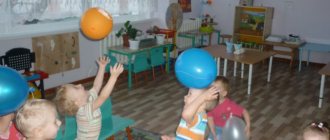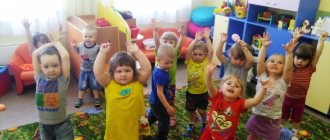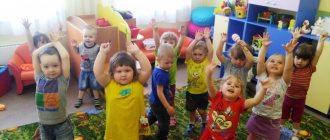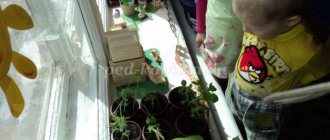Goals and objectives of outdoor games
In the first junior group, special attention is paid to games that require varying degrees of mobility for children. Such fun is the main form of fulfilling the mission of the educational process, which consists in:
- ensuring the versatile development of children (physical, emotional-volitional, spiritual);
- health promotion;
- developing the skill to follow the rules of the game;
- stimulating the desire to play with friends and adults;
- nurturing the need to be part of a team.
Outdoor games are a collective type of work that fosters a spirit of cooperation in children.
The implementation of the set goals in the first junior group is possible with the systematic and consistent solution of the tasks of conducting outdoor games:
- strengthening the musculoskeletal system;
- mastering the skill of performing simple motor exercises together with a teacher and peers, accompanied by a simple plot;
- improving basic movements (running, walking at different paces, throwing and rolling a ball, jumping);
- learning to express movements through imitation (jumping like bunnies, drinking water like chickens, etc.);
- training the ability not to lose orientation in the playing space;
- practice the skill of moving one after another and completing the movement at a certain signal from the leader (teacher);
- developing the skill of coordinating one’s actions with the rules of the game and other participants;
- encouraging independence.
TOP toys
When choosing educational games and aids for a nursery group, you need to pay attention to their functionality, developmental focus, age-appropriateness and safety. When evaluating toys for primary preschool age, we considered precisely these criteria. The top positions in the ranking included:
- constructors with 25-30 large parts;
- classic pyramids with 4-5 rings and one pin;
- puzzles consisting of 4-6 fragments;
- frames with images of animals, fruits, vegetables, transport;
- sorters with a base in the form of a container with holes;
- business boards based on Russian folk tales;
- lacing rollers;
- lacing beads;
- labyrinths with multiple routes;
- musical instruments: metallophone, xylophone;
- themed lotto.
In addition to the didactic games necessary for children in the nursery group, they must have items for active activities. Among the popular ones:
- balls of different sizes;
- hoops;
- jump ropes;
- ring throwers;
- throwing bags;
- bowling sets.
We must not forget about materials for creativity: finger and regular paints, easels, plasticine, applique kits.
Classification of outdoor games
The variety of tasks for conducting this type of fun makes it necessary to systematize outdoor games by type, namely:
- to develop the ability to run and jump (it is difficult for younger preschoolers to coordinate their movements, in particular, to move in one direction);
- for orientation in space;
- to develop balance (for example, in games of walking on a limited surface to rhythmic lines);
- to strengthen the muscles of the torso, back, spine, arch of the foot;
- for imitation;
In imitation games, children not only try to repeat the movements of animals and adults, but also imitate different sounds.
- with a ball (including for the formation of partnerships between children);
- to master the skill of climbing;
- on the development of attention.
Based on their place in the educational process, games for children aged 1.5–3 years can be divided into four types:
- fun for a walk (carried out on the street);
- physical education breaks (organized during classes for relaxation and change of activities);
- leisure activity (for spending time outside of classes - on a walk, at matinees, in the process of independent activities);
In the warm season, outdoor games are the main activity during a walk.
- folk game (to get acquainted with the traditions and customs of your people).
Based on the types, we can conclude that outdoor activities are carried out at every lesson not only in the form of a physical education break, but also in separate lessons: physical education, choreography (if this discipline is included in the preschool educational program), music class.
Finger games for nursery group
Scientists have long proven that the nerve endings located on the fingers have a connection with the part of the brain responsible for speech. Therefore, to improve this skill, teachers use activities aimed at training fine motor skills, and in particular, finger games. They bring great pleasure to children, and in addition they develop:
- coordination of movements;
- finger flexibility;
- tactile sensitivity;
- mental functions: speech, memory, thinking, attention, curiosity.
Regular gymnastics for fingers is still uninteresting for children aged 2-3 years, so classes are carried out in the form of acting out a fairy tale (rhyme) or manipulative games with special aids: pyramids, lacing, labyrinths, clothespins, containers with bulk material, mitten dolls.
Techniques
To successfully conduct an outdoor game, a combination of three groups of techniques is used.
Verbal
Despite the fact that at 1.5–5 years old not all children speak, the teacher should pay as much attention as possible to verbal explanation. Firstly, children enrich their vocabulary (even if it is still passive), secondly, the adult appears as a speech model that encourages children to perform their own speech acts, thirdly, pupils learn to follow verbal instructions. Among verbal techniques, two are especially productive.
- Explanation. The only suitable technique is during the first half of the year, when children are just delving into the new role of kindergarten students, getting their first ideas about the role of an adult in the new team, and also getting used to each other.
- Puzzles. Their use is possible from the second half of the year, when children accumulate not only knowledge, but also vocabulary. At the same time, it is advisable to select riddles with agreements, so that it is easier for the children to select answers that match the rhyme and rhythm of the lines. For example, before the game “The Cat and the Sparrows,” the teacher asks riddles: “He doesn’t sleep at all at night, He guards the house from mice, He drinks milk from a bowl, Well, of course, it’s ... (a cat)” and “This bird doesn’t walk, Calls: “ Don’t be timid!” The most important bully is Gray-brown... (sparrow).”
Riddles are used as a motivational device before starting a game.
- Short tales. The teacher usually comes up with such stories himself based on the plot of the game. For example, the teacher prefaces the beginning of the explanation of the rules of the game “Sunshine and Rain” with the following: “A long time ago, Sunshine and Rain were very friendly. But somehow they decided to play a game in which the Sun was supposed to shine and be happy, and the Rain was supposed to be sad and dripping. And the flowers and animals liked this game so much that since then Rain and Sunny have been unable to change places. So it turns out that the Sun warms us, and the Rain wets us.”
Visual
Visual perception for children who have almost no speech is a necessary means for understanding the task. For outdoor games the following are used:
- pictures (depicting the heroes of the game - cats, dogs, etc., children playing);
- toys on behalf of which the fun is carried out;
- demonstration (the teacher’s participation in all fun activities is a prerequisite for play activities in the first junior group, so the teacher first demonstrates the actions of all the participants himself, and then the children repeat them).
The teacher shows all the roles and reserves the mission of the driver
Practical
This group of techniques includes the actual play actions that children perform together with an adult.
This is interesting. To develop independence, with each subsequent repetition of the game, the teacher reserves less and less game actions. So, if the first few times an adult takes on the functions of a leader, then when the fun is repeated, this role passes to the children.
Safety requirements
Any toy must have a quality certificate, be safe and not pose a threat to health. Among the mandatory requirements:
- no rust, traces of insects, visible damage;
- materials, including finishing (paint, varnish) - non-toxic;
- parts and surfaces should not have hard sharp edges or burrs;
- the top protective layer must withstand the effects of saliva and wet processing;
- absence of glass, porcelain, pile materials, filling with granules less than 3 mm in diameter;
- part size more than 4-5 cm;
- structural elements must be securely fastened;
- musical instruments should have a pleasant sound.
When purchasing toys, you need to carefully consider the packaging. The following should be indicated here: the name of the manufacturer, his details, the recommended age for which it is intended, operating instructions and date of manufacture.
Well-chosen games for the garden, in particular for the nursery group, help organize the correct subject-spatial environment necessary for the effective development of children. But this is only half the success. Children will need help and guidance from adults. After all, two or three year olds are not yet able to use all the learning potential inherent in toys.
Rules of organization and conduct
- Outdoor games are held every day.
- In the first junior group, the game should not last longer than 6–8 minutes.
- 1-2 outdoor games are played at one time, one requiring more active movements (for example, running), and the second less (with spatial orientation).
- When conducting fun indoors, the room must be ventilated and wet cleaned.
- Games are played with all children together or in small groups so that every child can participate.
- During the walk, outdoor activities are organized immediately after leaving.
- You cannot insist on your child's participation in the game if he does not want to. In this case, it is necessary to find out the reason for the refusal (perhaps the baby is embarrassed to make a mistake or is afraid of falling or hurting himself, in this case therapeutic fairy tales on the topic, cartoons suitable for the problem will help).
- If in the first half of the day there are physical education classes (choreography, music), then a quieter game is held outside, and after sleep, fun activities of various mobility are organized.
- During the game, the teacher provides assistance to each child (helps to catch a ball, spin a hoop). At the same time, he himself remains in the position of a leader, guiding and showing the kids how to play.
- For the plot of the fun, characters well known to children are selected: bunnies, cats, birds. It is important that the character is represented visually: with a picture, a toy.
- The games use only simple tasks: ring the bell, catch the ball, bring the skittles, etc.
- The fun plot includes not only new, but also well-practiced exercises. For example, when mastering the movement of a locomotive in the game “Train”, kids get out of the “cars” and walk around the “clearing”, and then cross the “bridge”, that is, they perform the well-known balance movement.
- Before playing the game, children need to be introduced to the rules, highlighting those signals by which children will have to change the nature of their movement (for example, upon hearing the ringing of a bell, sit down, or stop when the leader claps his hands). And also demonstrate the attributes that will be required for the game (ball, toy, hula hoop).
After the teacher has introduced the attributes of the game to the kids, you need to give the children a few seconds to try this equipment in action.
- Help the children during the game (suggest movements, show their starting places, etc.), using facial expressions, gestures and different intonations in the voice.
- When organizing a game, the teacher needs to carefully think through all the necessary materials, mark out places for “houses”, “nests”, etc.
- The same game is repeated for 2-3 days in a row, then a new one is learned, after which you need to return to the previous ones. In this case, it is necessary to take into account the mobility of each child, that is, stop one in time or change the role of another. It is only important not to go against the characteristics of temperament. For example, a melancholic person should not be forced to run, even if he has not yet fulfilled this role, but a choleric person will quickly get bored with just catching the ball - such a fidget needs to run.
- It is important to ensure that children do not become overtired. So, paleness, red faces, excessive sweating, distracted attention are signs that the game needs to be stopped.
The teacher must ensure that children do not become overtired during the game.
- The teacher should be moderately emotional, cheerful, active and friendly - these manifestations attract children to the game.
Card index of outdoor games in the junior group
Unlike didactic games, which are planned in accordance with the lexical topic being studied, outdoor fun can be grouped according to three principles:
- on practicing one or another physical skill;
- complexly, when several tasks are implemented in one block at once (that is, games are taken of different types);
- thematically (fun is selected according to lexical topics).
The last principle of grouping games is less productive, since the plots of fun for the first younger group are so simple that changing the characters is not difficult. For example, a game to develop running and jumping skills “Birds in Nests” (children stand on a raised platform, at an adult’s signal, “fly away”, and then return back to the words “It’s raining!”) can turn into a fun game “Cat and Mice” or "Chicks and the Fox."
The game Engine can easily turn into a Bus, Tram or Caterpillar - depending on the topic being studied
The most convenient way to compile a card index of games is to follow the principle of a skill being practiced.
Running, jumping
- “Sun and Rain” (options “Rain”, “Sunny Bunnies”). The purpose of such fun is to train kids to run in different directions without colliding with each other. And also walk and squat at the teacher’s signal. Conditions: the teacher marks the line beyond which the children squat. When the driver says that there is not a cloud in the sky and we can go for a walk, the kids run around the room. After the words: “It’s going to rain,” they run over the line again and sit down.
- Russian folk game “Cat and Mice” (the game “Cat and Sparrows” is organized according to the same principle). Objectives: stimulate motor activity of children. Conditions: the cat lives in a house on a chair, mice also have chair houses. The cat shows off while the mice are in the houses. A lullaby sounds and the cat falls asleep in the house. The mice come out of their holes with the words: “Hush, mice, the cat will hear,” and move towards the cat’s house. To the loud sound of a tambourine, the cat wakes up and runs after the mice. They run away, and those who didn’t make it in time become a cat.
- "Aircraft". Objectives: to practice the ability to run in different directions, not to collide with each other, to teach them to strictly follow the instructions of the driver. Conditions: the teacher shows how to start the engine of an airplane (waving your arms to the sound “r-r-r”), how the plane flies (arms to the sides) and how to land (we sit down on a bench). Next, the teacher commands: “Get ready! We are checking the readiness of the engines!”, “Let’s fly!”, “For landing!”
- “Run to me!” Objectives: to train the ability to run straight for everyone together at the same time. The children and the teacher stand at different ends of the playground. The adult says: “Run to me!” The kids rush to him, and the adult tries to hug everyone. Then he goes to the opposite end of the room and repeats again: “Run to me!”
You can complicate the task by not only running up to the teacher, but also picking up a turntable from the ground, for example
Orientation in space
- "Train". Objectives: teach kids coordination of actions, move in formation, change the pace of movement according to a conventional sign. Conditions: children stand at the back of each other’s heads, without touching those in front with their hands. The first child is a train, the rest are carriages. At the conditioned signal from the teacher, the locomotive and carriages begin to move. After the words: “The train is approaching the station,” the children begin to move a little slower. The teacher invites the participants to take a walk and walk around. Based on the conventional sign, you need to restore the sequence of cars as quickly as possible.
- "Cars". Objectives: to teach to maintain direction of movements, not to push, to develop attention. Conditions: the teacher marks the line beyond which the “garage” is located. “Cars” - children go to the playground, drive, observing basic rules (for example, do not push, go around, giving a signal). After the words: “Cars, into the garage!”, the kids return to the line.
- "Leaflets" ("Leaf Fall") Objectives: teach children to move to rhymed text. Kids take leaves and perform the following actions: wave the leaves, changing the direction of movements, spin and squat, put leaves under their feet.
Development of balance
- "Carousel". Objectives: to develop children’s balance and the ability to change the pace of running. Conditions: the teacher puts on a hula hoop with ribbons attached to it. Children take hold of these ribbons and, according to the adult’s instructions, either speed up or slow down the pace of movement.
Instead of a hula hoop in the Carousel game, you can use an umbrella
- “Who is quieter?” Task: practice walking on your toes. Conditions: the teacher invites the kids to quietly approach the toy (bear, bunny). And then, moving to the other side, he says: “Now run to me!” Children are running.
Imitation skill
- "Bubble". Objectives: to teach children to act according to verbal instructions, to develop imitation, as well as coordination of movements. Conditions: teacher and children dance in a circle. The teacher repeats the phrase 2-3 times: “Inflate the bubble, inflate the bubble, but don’t burst.” The children disperse without opening their arms. To the words: “The bubble has burst!” The kids disperse and say the sound: “Sh-sh-sh.”
- "Cockerel." The tasks are the same as in the previous game. Conditions: in , the children walk around him, and when he says: “Crow,” they run away, and he catches them.
Agility development
- “Hen and Chicks” (the game “Rabbits” is organized according to the same principle). Tasks: to teach kids to crawl under a tense barrier, to be careful, to act according to a conventional sign, to help each other, not to push. Conditions: a tape is stretched between the chairs at a height of 30–40 cm from the floor. On one side there is a “hen” with “chicks” (children), on the other there is an “eagle” (teacher). Children climb into the territory of the “bird” in search of food, at the signal: “Eagle” they climb under the tape into the house.
To make the games even more interesting, you should find suitable hats and masks
- "Frogs" Objectives: practice jumping forward on two legs, jumping over an obstacle (rope) placed on the floor. Conditions: in one part of the site there is a “swamp” rope. To the words of the teacher, the kids jump to the swamp. When jumping over the rope, they say: “Plop.”
Climbing skill
These are games related to exercises on the gymnastic wall. In the first junior group, kids complete the “Monkeys” task, in which they must climb 3-4 steps of the wall. The rest of the participants are watching. Do the task one by one.
Development of attention
- "Catch the ball." Objectives: teach kids to catch balls with both hands, stimulate independence, develop attention. Conditions: the teacher calls the kids in groups of 2-3 and rolls balls for them in different directions. At the request of an adult, children carry exactly the balls that were designated for them.
- "Flag". Objectives: to practice the skill of performing actions under verbal instructions, to train attentiveness. Children stand in a circle with a flag in the center. The teacher calls the child, he raises the flag, waves it and places it in a circle. And so on in turn.
Musical games for nurseries
Music helps you loosen up, relieve muscle tension, overcome psychological pressures, and make it easier to adapt to an unfamiliar group. In addition they:
- develop a sense of rhythm and musical taste;
- stimulate the imagination;
- improve mood;
- strengthen the body (muscles, heart, blood vessels, respiratory system).
Musical activities in a nursery group usually involve staging nursery rhymes, round dances to various melodies, or guessing the sounds of various instruments. Eg:
- "Do it in this way!". Having lined up, the children walk in a circle to cheerful music. The teacher sings a song, and when he gives the signal: “Stay still! Come on, let’s do it like this!”, all participants must repeat after the adult the movement shown to them: sit down, jump, clap, raise your arms up, rest them on your sides or spread them out to the sides.
- “Vanya is walking.” The children, holding hands, lead a round dance. The leader (from among the students) is in the center. The kids sing a simple song: “Vanya went, Vanya was looking for a friend for himself! ( 5 times). Vanya has found a friend for himself!” At the last words, the kids stop, and the leader chooses a mate. They dance together in the center of the round dance. At this time, other participants clap their hands, spin, and stomp to the music. The teacher changes the leader, and the fun continues.
- "Bunnies and the wolf." Cheerful music plays, symbolizing the coming of a new day. The bunnies wake up and run out onto the lawn to frolic. The music changes to menacing - the wolf (leader) has come. He runs after the hares, trying to catch up. The melody becomes calm and quiet. This means that the terrible beast has run away, and it’s time for the bunnies to sleep. They go to their houses (on the bench) and calmly “fall asleep” to the lullaby.
- "Guess the musician." The teacher says that the bear cub has a drum, the bunny has a metallophone, and the Masha doll has a whistle. The toys “hide”, one of the instruments sounds, and the students determine who is playing it.
Another interesting option for musical classes is to dance only with your arms, legs, and eyes.
Timing game plan
As noted above, the duration of outdoor play in the first junior group is 6–8 minutes. During this time period, the teacher and children work through 5 stages.
- The beginning of the game, that is, an introduction to the game situation, awakening interest in the fun (half a minute). The teacher says the name and basic actions (“In this game we will run/jump/squat”, etc.).
- Introduction to the rules (1 minute). The adult describes in detail the rules of the game and shows the actions that the children have to perform.
Game actions are necessarily preceded by a detailed explanation of the rules
- Solving a game problem, that is, the actual game actions (2–4 minutes).
- Clarifying or complicating actions (2 minutes). If the game is new, then this step is skipped.
- Completion of the game, reflection (half a minute). The teacher praises the children for their activity and asks if they liked the game.
Table: example of a summary of the outdoor game “Sparrows and a car” in the first junior group
Author - Romanchenko N.V., teacher of the MBDOU Mankovsky kindergarten, p. Mankovo-Kalitvenskoe, Rostov region.
| Stage | Content |
| Introduction to the game situation | Children listen to a recording of a sparrow singing. Educator: “Children, who sings this?” Children's answers. The sparrow jumps and jumps Calls the little children Throw some crumbs to the sparrow I'll sing you a song. Tick-tweet! Throw millet and barley - I will sing to you all day long. Tick-tweet! Chick-chirp!..> <…“Once upon a time there were little gray sparrows. On a clear sunny day they flew around the garden and looked for grains or insects. They flew up to the puddle, drank some water and flew away again. One day, a large car suddenly appeared and started blaring “beep-beep-beep.” The sparrows got scared and flew away to their nests. |
| Introduction to the rules | Let's play this game. You will be little sparrows. The chairs will be your nests, and I will be the car. Turn around yourself, turn into little sparrows! Let's remember how sparrows fly and jump. I fly along the street, I live under the roof (flapping their wings) A sparrow is looking for crumbs in the yard (bends down or squats) A small bird, has claws, does not know how to walk (jumps on two legs). And now the rules of the game: sparrows sit on chairs, these are nests. At a signal, they fly out, jump, and peck the grains. And as soon as the car, I will be the car, starts buzzing “beep-beep-beep”, all the sparrows fly to their nests. |
| Solving a game problem | “The sparrows flew to us. And they began to live in nests here on chairs. “Let the sparrows fly into the house” (the tambourine is silent). “And here in the garage there was a car (I take the toy car and put it aside).” “The car is in the garage - sparrows run out of the house (tambourine sounds). Let's wave our wings (showing, let's peck the grains (showing). Let's chirp for joy (“chirp”)." I go up to the car, take a toy and say: “The car has left the garage - beep, beep - fly away the sparrows to the house so that the car will take you didn’t run over" (the tambourine is silent). I drive the car by the string. When the children all sat down on the chairs, I say: “Well done, sparrows, they flew away quickly, the car didn’t run over anyone.” I take the car “to the garage”: “The car has left - fly out the sparrows.” The game is repeated 3-4 times. |
| Complication | Educator: “And now another driver, Dimochka, will drive the car. And we will continue the game." |
| The final stage | The teacher thanks all the children for their active participation. |
| https://www.maam.ru/detskijsad/podvizhnaja-igra-v-pervoi-mladshei-grupe.html | |
Video: outdoor game “My funny ringing ball”
Video: outdoor game “Mice and Babies” for the first junior group
Analysis and self-analysis of outdoor games
Both types of analysis are carried out according to the same scheme, with the only difference being that the analysis is carried out by observers, whose role is played by colleagues and methodologists, and self-analysis is carried out by the teacher himself. The first assess the level of methodological literacy of the teacher when conducting the game and the preparation of children in the process of performing game actions. The teacher, through self-analysis, helps himself to identify organizational shortcomings in his work. In addition, both self-analysis and analysis assess the level of creating a positive microclimate in the children's team.
Parsing protocol
- Game start time.
- Number of players.
- Correspondence of the goals and objectives of the fun to the age of the kids.
- Who initiates the game? In the first junior group, this role is always played by the teacher.
- Techniques for creating interest in the game (riddles, explanations, showing pictures).
- Logical explanation (repetition) of the rules of the game. It is important to note whether the teacher named the location of the players and listed the attributes that the kids will need. It is important not to be distracted by comments during these explanations.
- Children’s acceptance of the rules of the game, reasons for violations (if any).
In the same paragraph, the reasons for the aggressive behavior of children during the game are analyzed, if such manifestations were
- Assessment of the level of preparation of attributes (done by the teacher himself, ready-made).
- The way to distribute roles in the game. For the first junior group, the teacher distributes them himself. In the second half of the year, it is possible to use counters to identify the characters in the game.
- The level of children’s performance of game tasks (how they overcome difficulties, whether they provide assistance, whether they show restraint).
- How developed are children's agility, speed, and endurance? It is important that kids not only perform playful movements, but also take the initiative to create combinations of actions.
- Compliance with ethical standards of behavior during the game. This criterion evaluates the manifestations of mutual assistance of young pupils in relation to each other, the development of the ability to find a common language, and the ability to give in.
- Assessing the role of the educator. How appropriate and logical are the teacher’s advice during the game, how often does he take on the role of observer.
- How does the summing up take place: does the teacher celebrate the distinguished children, does he praise everyone.
- Duration of the game and number of repetitions.
Outdoor games in the first junior group are aimed at developing physical abilities and strengthening the health of children. In addition, carrying out such fun in classes and during leisure time contributes to the socialization and development of speech in children aged 1.5–3 years. To successfully implement the assigned tasks, the teacher must take into account all the requirements for organizing and conducting outdoor games, as well as apply the maximum of his methodological knowledge to develop a detailed outline of gaming activities.
Features of games for kindergarten children
Play activities in preschool educational institutions determine the direction of the physical, intellectual, and psychological development of children. In addition, they form the strong-willed and moral qualities of the child and reveal his creative potential. Games for the nursery group have a number of features that are expressed in the goals and techniques used by teachers to implement them.
The mission of games for children attending nurseries combines three areas:
- Didactic (educational). For example, when changing clothes for a doll, kids learn the name of items of clothing, the order of putting them on/taking off, and their correspondence to the weather and seasons. And by putting puzzles together, they get to know animals, vegetables, and fruits. The “clean tables day” announced in kindergarten teaches children to eat carefully.
- Developmental. The fundamental goal of educational games and exercises for kindergartens is speech training. Kids should not only “talk”, but also work on improving this skill. No less important is the effect of toys on memory, attention, thinking, imagination, and stimulation of cognitive activity.
- Educational. At 2-3 years old, children must learn patience, proper communication, cooperation, and acquire correct moral ideas. Another important skill that students acquire during play activities is self-regulation or extinguishing negative emotional impulses.
To successfully implement the goals and objectives, educators adhere to certain principles when organizing play activities.
Among them:
- Easy to understand. So, children are not yet able to lay out mosaics or puzzles consisting of a dozen fragments. But repeating a finished drawing with elements of toys is quite an accessible activity.
- Dynamism. Children attending nurseries can maintain attention for no more than 10 minutes. This feature dictates a regular change of activities.
- Visibility. For the fun to be as useful as possible, kids need to see the actions that they will perform in the future. They are offered thematic pictures, presentations, and a preliminary “playing out” of the scenario by the teacher.
- Goodwill. A good mood and a kind attitude from an adult are a prerequisite for joint entertainment.
- A combination of collectivity and individuality. Peculiarities of age do not yet allow organizing a full-fledged collective game. It is replaced by performing a single task, but by each student individually.
- Competitiveness. Until the age of 3, children do not understand what competition is. The teacher introduces this concept gradually, first through a general assessment of the group, then identifying the most successful participant.
An approximate list of toys for children in the nursery group of a kindergarten can be found in the corresponding document of the Department of General Education of the Ministry of Education and Science of Russia. We offer a selection of exciting, useful activities. And at the end of the article we will present the TOP toys you need.






